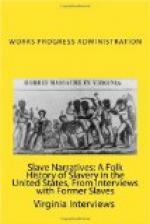“The first teacher I had was Katie Whitefold (white). That was in Waterloo. Miss Richardson was our next teacher. She was white too. We went to school two terms under white women. After that we began to get teachers from Columbia, South Carolina, where the normal school was.
“The white teachers who taught us were people who had been raised right around Waterloo. We never had no Northern teachers as I knows of. Our first colored teacher was Murry Evans. He a preacher. He was one of our leading preachers too. After him our colored women began to come in and stand examination wasn’t so hard at that time, but they made a good showing. There were good scholars.
“I went to school too much. I went to school at Philander Smith College some, too. I went a good piece in school. Come pretty near finishing the English course (high school). I finished Good[HW: sp.?] Brown’s ’Grammer of Grammers’. Professor Backensto (the spelling is the interviewer’s) sent away and got it and sold it to us. We was his students. He was a white man from the North and a good scholar. We got in those grammars and got the same lessons they give him when he was in school—nine pages a lesson and we had to repeat that lesson three times. When my mother died, I was off in the normal school.
“Right after the war, my parents farmed. He followed his trade. That always gave us something to eat you know. When we farmed, we sharecropped—a third and a fourth—that is, we got a third of the cotton and a fourth of the corn. Potatoes and things like that went free. All women got an acre free. My mother always got an acre and she worked it good too. She always had her bale of cotton. And if she didn’t have a bale, she laid it next to the white folks’ and made it out. They knew it and they didn’t care. She stood well with the white people. Helped all of ’em raise their children, and they all liked that.
“I went along with my father whenever he had a big job and needed help. I got to be as good a carpenter as he was.
“I married out here. About eighty-five. People were emigrating to this country. There was a boom to emigrating then. Emigrating was a little dangerous when a man was trying to get hands. White folks would lay traps and kill men that were taking away their hands—they would kill white just as quick as they would black. I started out under a white man—I can’t remember his name. He turned me over to Madden, a colored man who was raised in Waterloo. We came from there to Greenwood, South Carolina where everything was straight. After that we had nothing to do but get on the train and keep coming. We was with our agent then and we had no more trouble after that.
“I got off at Brinkley over at Minor Gregory’s farm. He needed hands then and was glad to get us. He is dead now. I stayed in Brinkley the space of about a year. Then he gave us transportation to Little Rock. The train came from Memphis, and we struck out for Little Rock. I married after I come to Little Rock. I forget what year. But anyway my wife is dead and gone and all the children. So I’m single now.




